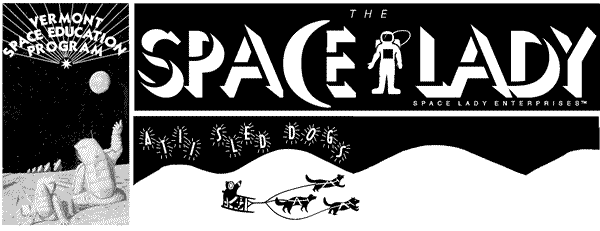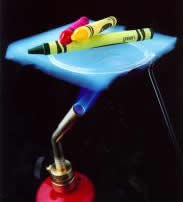|
|
These crayons are protected from melting from the heat of the torch by aerogel. Aerogel was created by scientists at the Jet Propulsion Laboratory (JPL). Aerogel was used to capture dust particles from Comet Wild as part of the Stardust Mission. The Stardust return capsule returned to Earth safely in January 2006. Scientists are examining the samples to learn more about our universe. |
SPACE EDUCATION LINKS AND RESOURCES
The following links are provided as suggested, recommended resources for educators, students and the general public. VSEP/Gail is familiar with each of them and has personally visited and reviewed them. Most of these sites are "living and growing"—meaning they are not static and are subject to modification and change. That's a good thing. However, you may occasionally find older, outdated information so look for dates such as "updated on." (Caveat emptor—or in this case, visitor beware.) Check back as new links get added to this page and throughout the website. There are lots more resources I can share with you, so consider taking a workshop from me or have me work with you at your school.
Find Endeavour and the International Space Station (ISS) in the night sky.
Use the following instructions to find out where and when the ISS will be over your home! (During the current STS-118 mission you get a bonus while Endeavour is presently docked to the ISS.)
If you are at the VPR/Fairbanks Museum star party tonight (8/13/2007) you will have an opportunity to see the International Space Station and Endeavour orbiting while docked together. It will look a bright moving star. Best viewing time tonight is from 10:02 to 10:03 pm (you'll only have that one minute duration). There will be a 3 minute duration at 8:26pm--but it will be harder to see due to the sunlight.) For specific coordinates, direction and degree of elevation follow the link and directions below.
Go here, then click on the left side picture "Space Station Sightings." On the new page, choose your country in the left-hand fly-out, then click "Go to Country." On the new page, choose your state, then pick the closest town/city to your home or viewing location. This will give you a number of possible sightings for several days at the location you've picked.
Here's a quick way to approximate "degrees of elevation" when looking at the night sky. Make a fist and hold it with your thumb on top. Hold your arm straight out with the bottom (the pinkie side) pointing to the horizon. The top of your fist is now at 10 degrees elevation. If the ISS is, for example, at 33 degrees in elevation, that's 3 fists plus a smidgen more.
On some dates the ISS won't appear in your viewing location because the sightings listed are only in twilight or post-sunset times. In reality, the ISS may have orbited over your viewing location during the day but the sunlight makes it too difficult to see the orbiting ISS. Obviously, cloud cover will be a factor in trying to see the orbiting ISS. The orbiting ISS will look like a bright moving star--don't forget it's orbiting at 17,500 miles per hour while in "low Earth orbit"--which is about 350-400+ miles above Earth's surface!
Happy Viewing!
GENERAL RESOURCES
Christa McAuliffe Center
Challenger Center for Space Science Education
NASA RESOURCES
NASA Home Page
NASA Goddard Space Flight Center
NASA Jet Propulsion Laboratory
NASA JPL Education Gateway
NASA Kennedy Center Home Page
NASA KSC Video Feeds (Live internet video feeds)
NASA Mars Pathfinder Mission
Hubble Space Telescope
NASA Space Shuttle, International Space Station and Current Events
NASA's Shuttle and Rocket Missions—Launch Schedule
International Space Station (ISS) Location Tracker
NASA Astronaut Biographies
NASA Classroom of the Future
NASA’s Classroom Calendar
NASA CORE Education Resources
NASA Education TV Schedule
NASA’s Quest (Education Projects)
NASA for Educators (see NASA’s Home Page for the link)
NASA’s Educator Astronaut Program (Overview information)
NASA’s EdSpace (NASA’s Educator Astronaut Program main web site. Information about missions for educators, students, and the general public. Earth Crew has information about space-related educational activities.)
NASA’s Explorer Schools Program
NASA for Kids
NASA’s Space Place for Kids
NASA for Students (see NASA’s Home Page for the link)
NASA Space Science Education Resource Directory
NASA Thesaurus (to help you understand all the acronyms, etc.)
Space Day
ASTRONOMY & CELESTIAL EVENTS
Lunar Eclipse Information for Aug. 28, 2007's total lunar eclipse
Lunar Eclipse Information (great content background courtesy of Goddard's Sun-Earth Connection site)
Lunar Eclipse Content and webcast (If Vermont skies are too cloudy for visibility there is a webcast courtesy of the University of North Dakota. Click on their "webcast" page for information.)
Lunar Eclipse Education Activities
Lunar Eclipse Photography (How to take good photos.)
NASA Astronomy missions and current celestial events
NASA’s Solar System Exploration (Lesson Finder)
Ask Dr. Universe
Amazing Space (Uses the Hubble Space Telescope's discoveries to inspire and educate about the wonders of our universe.)
Exploring Planets in the Classroom (Activities from the University of Hawaii’s Space Grant program) Please be sure to give them credit as instructed on their webpage.
Interactive Sky Charts
The Nine Planets
Solar System Live
Space Explorers (Fee-based products and programs)
StarChild
Star Journey (National Geographic's site)
Welcome to the Planets
METEOROLOGY / GLOBAL WARMING / CLIMATE CHANGE
Weather
Climate Change
There are many great sites. This is just one place to get you started. They have links to other sites as well.
Go North! Authentic adventure learning using computer technology, distance learning and hands-on learning activities. What could be more exciting than sled dogs and climate change research in the global Arctic regions? How about having Gail bring her sled dogs to your classroom as part of this integrated learning unit? For K-12 classrooms to unlock the interactive world; for explorers of all ages!
Click here for a very short video to see what adventure learning is all about.
Click here for a pedological article to help support your inclusion of this program in your classroom. (PDF file)
International Polar Year (March 2007- March 2009)
"The International Polar Year is a large scientific programme focused on the Arctic and the Antarctic from March 2007 to March 2009.
IPY, organized through the International Council for Science (ICSU) and the World Meteorological Organization (WMO), is actually the fourth polar year, following those in 1882-3, 1932-3, and 1957-8. In order to have full and equal coverage of both the Arctic and the Antarctic, IPY 2007-8 covers two full annual cycles from March 2007 to March 2009 and will involve over 200 projects, with thousands of scientists from over 60 nations examining a wide range of physical, biological and social research topics. It is also an unprecedented opportunity to demonstrate, follow, and get involved with, cutting edge science in real-time."
IPY's Educator section:
NASA Goddard Institute for Space Studies Research at GISS emphasizes a broad study of global climate change.
MUSEUMS & Planetariums
National Air and Space Museum
Boston Museum of Science (IMAX theatre and Planetarium)
ECHO Center (Burlington, Vermont)
Montshire Museum (Norwich, Vermont)
January 2006 to March 2006: See a display of wonderful large images from the Hubble Space Telescope!
Fairbanks Museum and Planetarium (St. Johnsbury, Vermont)
Royal Observatory (Greenwich, England)
ROBOTICS
FIRST: For Inspiration and Recognition of Science and Technology This is a highly recognized program for students to get involved with hands-on robotic engineering and design projects.
* FIRST Robotics Competition for high-school students
* FIRST Tech Challenge for high-school students
* FIRST LEGO League for 9 to 14 year-olds
* Junior FIRST LEGO League for 6 to 9 year-olds
* FIRST Place for ages 6 to adult
OTHER MISCELLANEOUS RESOURCES
Ask Jeeves for kids
Science Buddies Get free help for Science Fair Projects and Research. Targeted for Middle and High School students with a truly useful Teacher Resources section. This is a great resource site that is very user friendly--even includes an interactive Topic Selection Wizard. Ask an Expert helps students with their project questions. Science Fair Project Guide is a great step-by-step "how to" section.
The K-8 Aeronautics Internet Textbook
Multi-level and in Spanish as well.
Teacherlink
Satellite Viewing
How Satellites Work
Starbase Vermont
Vermont Aviation Career Education Camp: ACE Camp
Vermont Space Grant Consortium/NASA EPSCOR
This page last updated November 20, 2007.
Vermont Space Education Program
Space Lady Enterprises
PO Box
550 · Moretown, VT 05660
Phone: 802-496-3795 · Fax: 802-496-3765
gbres@madriver.com
www.VtSpaceEducation.org
All
photos, art & content copyright © 2003-2007 VSEP/SLE
All rights reserved. No photo, drawing, or text may be reproduced in
any form without written consent.
Written
consent is necessary before linking this site to yours!
Please send your requests to: gbres@madriver.com or
VSEP,
PO Box 550, Moretown, VT 05660 |

